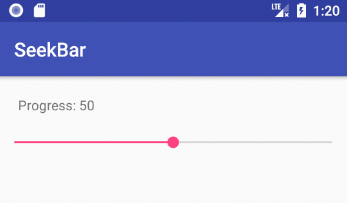Implementing a slider (SeekBar) in Android
How to implement a SeekBar

Add the SeekBar to your layout
<?xml version="1.0" encoding="utf-8"?>
<LinearLayout
xmlns:android="http://schemas.android.com/apk/res/android"
android:orientation="vertical"
android:layout_width="match_parent"
android:layout_height="match_parent">
<TextView
android:id="@+id/textView"
android:layout_margin="20dp"
android:layout_width="wrap_content"
android:layout_height="wrap_content"/>
<SeekBar
android:id="@+id/seekBar"
android:max="100"
android:progress="50"
android:layout_width="match_parent"
android:layout_height="wrap_content"/>
</LinearLayout>
Notes
maxis the highest value that the seek bar can go to. The default is100. The minimum is0. The xmlminvalue is only available from API 26, but you can just programmatically convert the0-100range to whatever you need for earlier versions.progressis the initial position of the slider dot (called a "thumb").- For a vertical SeekBar use
android:rotation="270".
Listen for changes in code
public class MainActivity extends AppCompatActivity {
TextView tvProgressLabel;
@Override
protected void onCreate(Bundle savedInstanceState) {
super.onCreate(savedInstanceState);
setContentView(R.layout.activity_main);
// set a change listener on the SeekBar
SeekBar seekBar = findViewById(R.id.seekBar);
seekBar.setOnSeekBarChangeListener(seekBarChangeListener);
int progress = seekBar.getProgress();
tvProgressLabel = findViewById(R.id.textView);
tvProgressLabel.setText("Progress: " + progress);
}
SeekBar.OnSeekBarChangeListener seekBarChangeListener = new SeekBar.OnSeekBarChangeListener() {
@Override
public void onProgressChanged(SeekBar seekBar, int progress, boolean fromUser) {
// updated continuously as the user slides the thumb
tvProgressLabel.setText("Progress: " + progress);
}
@Override
public void onStartTrackingTouch(SeekBar seekBar) {
// called when the user first touches the SeekBar
}
@Override
public void onStopTrackingTouch(SeekBar seekBar) {
// called after the user finishes moving the SeekBar
}
};
}
Notes
- If you don't need to do any updates while the user is moving the seekbar, then you can just update the UI in
onStopTrackingTouch.
See also
- SeekBar Tutorial With Example In Android Studio
For future readers!
Starting from material components android 1.2.0-alpha01, you have slider component
ex:
<com.google.android.material.slider.Slider
android:id="@+id/slider"
android:layout_width="match_parent"
android:layout_height="wrap_content"
android:valueFrom="20f"
android:valueTo="70f"
android:stepSize="10" />
- Release notes
- Material Design Spec
- Docs
Android provides slider which is horizontal
- http://developer.android.com/reference/android/widget/SeekBar.html
and implement OnSeekBarChangeListener
- http://developer.android.com/reference/android/widget/SeekBar.OnSeekBarChangeListener.html
If you want vertical Seekbar then follow this link
- http://hoodaandroid.blogspot.in/2012/10/vertical-seek-bar-or-slider-in-android.html